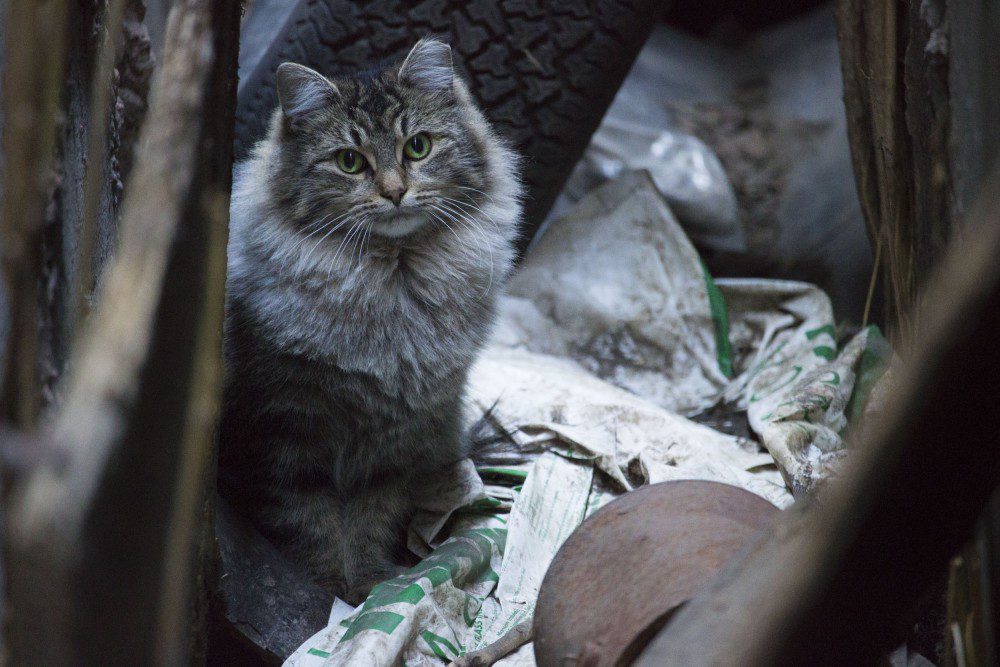This society is totally under wraps, and you’re lucky if you can catch a glimpse of it.
We’re talking about feral cat colonies. Wildcats, if you will. And there are clusters of them scattered around the city.
Christina Nielsen, 54, an artist from the Church Street and Wellesley Avenue area, heads up to Yorkville three times a week to care for one of the local colonies.
She first discovered it two years ago, one winter night leaving her gym.
“I think of it as a commercial area,” she said of the Yorkville-based feline community, adding that she never expected to spot a little tortoiseshell cat running across the street.
It never occurred to me that cats were living on the street.
—Christina Nielsen
Nielsen followed the cat into a small alleyway between two restaurants. She was curious if there were more cats, so she went and bought some treats from the dollar store.
When she returned, she found the cat and saw how desperate it was for a meal. “When I came back, it ate everything I had,” she said.
The next time she went to the gym, she came armed with cat food.
“I have two cats of my own,” she said. “It was so strange to me to see an animal that should be domesticated live in such a busy area.”
“I worried all those cold nights how they were coping, where they were finding shelter and warmth.”
When the weather warmed up, Nielsen took caring for the cats more seriously. She had found a dead kitten in May when she returned to the colony site for a regular feeding.
Overwhelmed with the scene and the idea that there were even more hungry kittens and mothers, Nielsen started to feed the cats more than three times a week.
I feel happy when I come home and I know that they have something to eat for a couple of days.
—Christina Nielsen
Yet, over the course of the summer, it seemed to her that someone might have also been feeding them since she had seen new bowls at the alleyway entrance.
She eventually found out about a program offered by several local volunteer groups that trap, neuter and return feral cats to their colonies.
This means that once the cats are trapped and spayed or neutered, they are returned precisely to where they were found — not put into shelters for adoption or euthanasia.
This is an effort at minimizing feral cat populations in Toronto, while still allowing the cats live within their colonies.
The program relies on clipping the cats’ ears to determine whether they have been spayed or neutered.
Before returning to the colony, a neutered cat will have the tip of one of its ears clipped so program volunteers will know which cats have been neutered.
Nielsen sees it as a humane attempt at population control.
“Yes, it has to be managed, and if it is, they would be a positive asset to the community, and they should be seen as such.”
Community Cats Toronto, also known as Toronto Feral Cat Project, works directly with volunteers in monthly efforts to trap, neuter and return feral cats. The program offers trapping workshops and cage rentals, operating in conjunction with the Toronto Humane Society and Toronto Animal Services.
The effectiveness of this program is measured in the decrease of feral cat euthanasia, a decrease in residential complaints.
“We are just starting to measure those kinds of benefits,” said the volunteer director, Penny Cookson.
“What’s amazing is how much support we are getting for this program.” The program has had more than 1,200 volunteers take its trapping workshop.
According to the Community Cats Toronto database, the average size of each colony in Toronto is 10 cats. With each volunteer colony manager taking care of 10 cats, the estimated numbers of feral cats in Toronto are staggering.
Toronto Street Cats is another coalition that is aligned with Community Cats Toronto. These volunteers are dedicated to building outdoor shelters for feral cats. They also offer workshops for new volunteers and colony managers to provide insulated winter refuge for the cats.
The goal for us is to decrease shelter euthanasia, and to increase the welfare of cats on the street.
—Dr. Hannah Booth, Toronto Animal Services
The goal for us is to decrease shelter euthanasia, and to increase the welfare of cats on the street,”said Dr. Hannah Booth, the founding member of Toronto Street Cats.
“Without programs like these, they would be on the streets without any warmth,” Cookson said.
Booth is also a veterinarian at Toronto Animal Services.
“We want to enhance communities, and not have the conflict between cats and the public. In all of these aspects, the coalitions are definitely working,” she said. “Strategic sterilizations are proving to be effective.”
Cookson and Booth both work to raise awareness. Cookson argues that the quality of life for a feral can be improved by “encouraging people to be concerned about the cats in their community.”
“It’s only through the people, in each neighbourhood, that we can all help them out,” Cookson said.
Nielsen hopes that these cats will continue to thrive but also recognizes that it is a hard life for a cat.
Construction, cold weather, and rushing cars continue to threaten these colonies.
Still, Nielsen sees these hidden communities as a gift.

Nielsen says to keep your eyes peeled for furry creatures. You never know when you might spot one.
“We can only feel that satisfaction when we see them peeking out, and just trustworthy enough that they’ll take your treats, or run by you,” she said.
“People are so absorbed in themselves, their world, and what they have to do that day – they may not stop to see a cat and wonder, where did that come from, and where is it going? But I can’t help but ask that question.”













